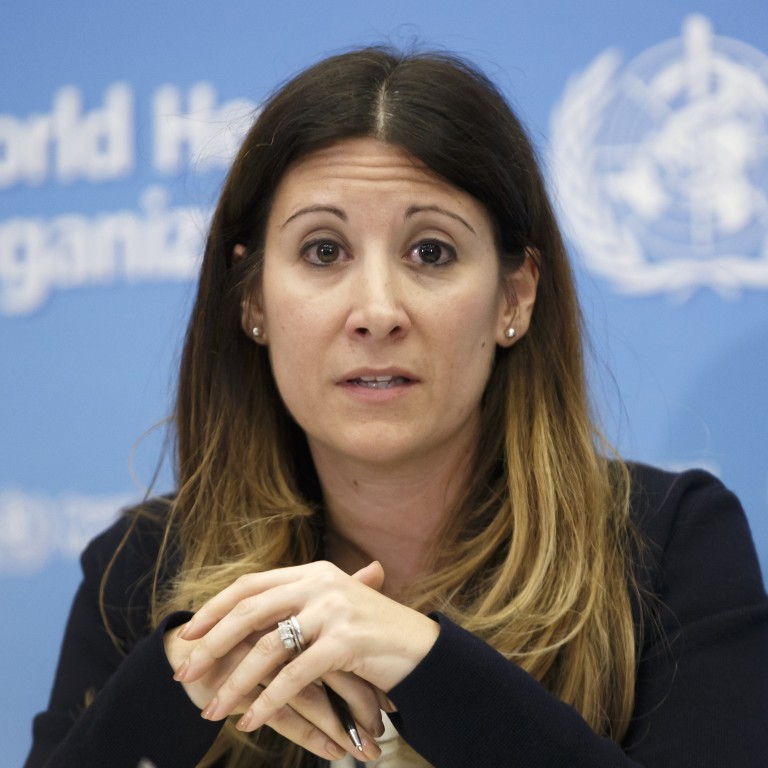
Coronavirus: Chinese data shows 82 per cent of cases are deemed mild, WHO says
- Top US public health official says he has ‘a lot of confidence’ in the data being provided by Chinese authorities
- Global health agency says ‘2 per cent or less than 2 per cent’ of reported cases in mainland have resulted in deaths
An initial analysis of 17,000 coronavirus infections in mainland China shows that 82 per cent of the cases are classified as mild and 15 per cent as severe, and that 3 per cent of patients have developed critical symptoms, the World Health Organisation said on Friday.
Maria Van Kerkhove, the technical lead in the world health body’s emergency programme, said the data obtained from Chinese authorities also showed that “2 per cent or less than 2 per cent” of reported cases have resulted in deaths.
“We know that individuals who are at an advanced age are at a higher likelihood of dying, we know that underlying conditions … make people more at risk,” Van Kerkhove said in the WHO’s daily briefing on the coronavirus outbreak.
Later on Friday, US health officials said they had “a lot of confidence in the Chinese data”, but added that there may be gaps in information because the statistics did not include infected people who did not seek medical attention because they had mild or no symptoms.
More than 31,000 people – mostly in China – have been infected, and all but two of the 638 deaths attributed to the virus have occurred in the Chinese mainland.
Van Kerkhove said there remained a need for additional studies on “critical unknowns” surrounding the virus.
She said the WHO was hoping more serologic assays – tests on the serum that separates from the blood when it is allowed to clot – would become available in coming weeks.
These tests will, among other things, give a clear picture on how many infected people have more mild symptoms, and the WHO has offered countries a recommended methodology on conducting them.
As countries prepare for an escalation in the outbreak – with signs of wider, community transmissions outside China – WHO chief Tedros Adhanom Ghebreyesus sounded the alarm on “severe disruptions” in the market for personal protective equipment.
Coronavirus: how a luxury cruise became ‘a floating prison’
“Demand is up to 100 times higher than normal and prices are up to 20 times higher,” Tedros said at Friday’s briefing. “This situation is exacerbated by widespread use of personal protective equipment outside patient care,” he said.
He said that the bulk of the personal protective equipment was needed in China and that the world body has held talks with manufacturers to make sure the items are available to frontline health workers and primary carers who need them most.
A study published on Friday in the Journal of the American Medical Association illustrated the dangers faced by health care workers dealing with infected patients.
The report detailed how 40 out of 138 people hospitalised in Zhongnan Hospital in the city of Wuhan – the epicentre of the crisis – were health care workers, with 10 of them presumed to have been infected by a single patient.
“WHO discourages the stockpiling of personal protective equipment in countries and areas where transmission is low,” Tedros said.
At Friday’s briefing, the WHO representatives also gave an update on efforts to help countries that are facing difficulties in diagnosing the coronavirus because of a lack of laboratories or insufficient supply of test kits.
Britain’s third coronavirus patient was infected in Singapore
Van Kerkhove said 15 laboratories around the world have agreed to accept tests from countries that need help. This week, the WHO shipped 250,000 test kits to 159 laboratories that have the “molecular capacity” to handle the tests, she said.
US health officials said on Friday afternoon that a clinical trial was underway in China to test the effectiveness of an antiviral medicine called remdesivir in treating the coronavirus.
Anthony Fauci, the director of the Centres for Disease Control’s (CDC) National Institute of Allergy and Infectious Diseases, said the trial – conducted in partnership with a Chinese researcher – was important to understand “what works and what does not work”.
“I think pretty soon we are going to get a definitive answer whether one of these among several drugs work,” Fauci said.

Also speaking at the briefing, the CDC’s director, Robert Redfield, responded to a question about the trustworthiness of Chinese data. Some observers have openly questioned whether Chinese officials were under-reporting the total number of infections.
But Redfield said the CDC had “a lot of confidence” in the data and that he and Fauci were in constant contact with their Chinese counterparts.
“I think the challenge is understanding more right now the spectrum of this illness, and it does appear that you can actually have this infection and not have symptoms,” Redfield said.
“Remember, China is looking at cases that were sick enough to go into a hospital and have to be admitted,” he said. “There's been very little broader look at the spectrum of this to see how many people are truly infected.”

